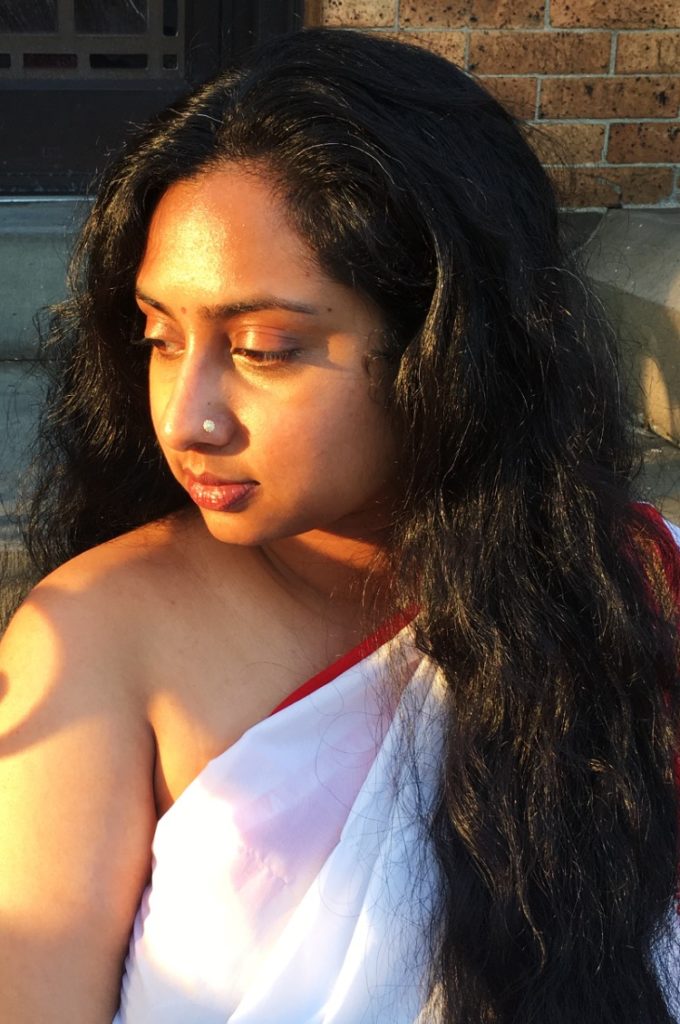
In 11th grade, one of the other Indian girls in my school got a nose job. She said it was to fix her “deviated septum,” but we all knew it was to shear off the classic South Asian bump on her nose. This was in the times of Paris Hilton, when rhinoplasty was the plastic surgery of choice among the American upper middle class. An aquiline nose had no place in a white, suburban high school.
I loved her nose bump, actually. I thought it was charming. It made me start to think more about my own nose — a large, almost perfect isosceles triangle from the side. Thankfully, I also have huge eyes, strong eyebrows, large lips, and round cheeks, so the big triangle looks proportional in the context of everything on my face. I doodled side-facing portraits of myself in math class, my nose alongside A = (1/2) bh , and wondered how to fill its surface area.
When I was in graduate school, I took a class with a crazy-haired old professor on ‘non-traditional psychotherapies.’ That meant that we spent one class trying out past-life regression. We were to close our eyes, and follow his prompts leading us further back and back into our life. We meditated, through our current age, to teenager, to preteen years, into childhood and infancy. Once we reached being in the womb — whatever our conception of that was — we were guided even further back. I was struck with a vision of being in a horse drawn carriage next to a huge palatial building in Kolkata (my dream just told me that’s where I was). I was sitting next to a man who I understood as being lower than my status in life, or forbidden in some way. He kissed my hand. There were flowers blooming outside, that I knew were planted just for me. This grandeur was my world.
When I awoke, I reveled in the fantasy of Hindustani nobility that had revealed itself to me. My nose became a confirmation of this aristocratic past birth: straight, large, with only the slightest bump. I dreamt about laying amongst silks, drinking tea in bed, a sitarist in my room playing soothing tones to lull me to sleep. My nose must have been bedecked with a huge diamond set in gold, or tiny sapphires and garnets in an intricate pattern. I started to feel that in this life, something belonged there, perched on the edge of my nostril. It might bring that dream into my reality.
I thought of queens, goddesses, all sorts of beauties borne from the imaginations of Hindustani poets and seers. They all had nose rings. My Kathak Guru, whom I adore, also has one. I loved how it sparkled on her expressive face while dancing. She recounted stories of getting her nose pierced as a young woman in Delhi. She had been somewhat pressured into it by a group of girls at her hostel at Kathak Kendra. The fine incision was made with the sharpened twig of a neem tree!
For me, things were different in this life. Guyanese girls don’t usually get nose piercings. In our culture, Indian traditions are sometimes thrown to the wayside as being too “coolie,” a term that was originally derogatory towards Indian indentured servants in the Caribbean. In some cases, British values eclipsed Indian traditions, and the nose pin was one of those. I grew up understanding that tattoos and nose piercings were something that “loose girls” did. That said, most elderly Indo-Caribbean women, including my own Nani, had tattoos done in the tribal Awadhi style after their marriage. I had seen old photographs of female indentured servants with multiple ear piercings, septum piercings, all of it. For my parents’ generation, wearing Indian adornments such as the nose pin meant regressing to the difficult and seemingly backward time of their ancestors. For me, it meant a return to the aesthetics that were meant to compliment my brown body. Silver Tiffany & Co. bracelets and necklaces just didn’t complement my features the way gold jhumkas did.
Without telling my parents about it, my best friend Sonal and I went to a little piercing spot on St. Mark’s in the East Village. I was familiar with this block, as it was a mainstay of punk and alternative culture in New York City. I used to go there on weekends in high school to buy things like black and white striped denim and combat boots. My piercing experience was much different than what I expect it was like for my ancestors. The young man who pierced my nose was incredibly stoned. He was quite good at his craft, though. I was nervous when I saw the black dot in permanent marker where he was to make the piercing. He stuck the needle in with one swift movement, and I only shed one quick tear out of my left eye. Sonal and I got fries at Pommes Frites right after. We took the rest of the day to go back to our apartment in Harlem and obsess over how much saline water needed to be applied, and how often.
My parents were shocked at first (though my Dad didn’t notice until five months after I had gotten the piercing), but they very quickly came to terms with the nose pin. They figured it was because I was hanging out with more Indian people lately, and besides, it could be taken out any time. I’m not sure if it has fulfilled my fantasies of being a reincarnation of Hindustani royalty. I still have yet to be romanced by a court poet or classical musician. Still, I’m happy when I see my nose pin glinting at the side of my triangle-nose from the corner of my eye. It’s a part of me, now.
Sarika Persaud is a psychologist and Kathak dancer in New York City. Her writings can be found at Sword and Flute.